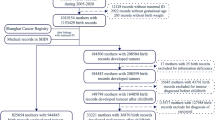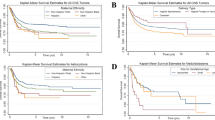Abstract
Perinatal risk factors including high birth weight have been associated with Wilms tumor in case–control studies. However, these findings have seldom been examined in large cohort studies, and the specific contributions of gestational age at birth and fetal growth remain unknown. We conducted the largest population-based cohort study to date consisting of 3,571,574 persons born in Sweden in 1973–2008, followed up for Wilms tumor incidence through 2009 to examine perinatal risk factors. There were 443 Wilms tumor cases identified in 66.3 million person-years of follow-up. After adjusting for gestational age and other perinatal factors, high fetal growth was associated with increased risk of Wilms tumor among girls (hazard ratio per 1 standard deviation (SD), 1.36; 95 % CI 1.20–1.54; P < 0.001), but not boys (1.10; 95 % CI 0.97–1.25; P = 0.14) (P interaction = 0.02). Among girls, high fetal growth was associated with disease onset before age 5 years (odds ratio per 1 SD, 1.47; 95 % CI 1.28–1.69; P < 0.001), but not beyond (1.00; 95 % CI 0.76–1.31; P = 0.99). No clear associations were found for gestational age at birth or other perinatal factors. In this large cohort study, high fetal growth was associated with Wilms tumor before age 5 years among girls. These findings suggest that early-life growth factor pathways for Wilms tumor may be more common among girls than boys. Further elucidation of these mechanisms may reveal better targets for prevention or treatment of specific subtypes of Wilms tumor.
Similar content being viewed by others
Abbreviations
- CI:
-
Confidence interval
- aHR:
-
Adjusted hazard ratio
- aOR:
-
Adjusted odds ratio
- IGF2:
-
Insulin-like growth factor 2
- SD:
-
Standard deviation
- WT1:
-
Wilms tumor 1
References
Chu A, Heck JE, Ribeiro KB, et al. Wilms’ tumour: a systematic review of risk factors and meta-analysis. Paediatr Perinat Epidemiol. 2010;24(5):449–69.
Schuz J, Schmidt LS, Kogner P, et al. Birth characteristics and Wilms tumors in children in the Nordic countries: a register-based case-control study. Int J Cancer. 2011;128(9):2166–73.
Bjorge T, Sorensen HT, Grotmol T, et al. Fetal growth and childhood cancer: a population-based study. Pediatrics. 2013;132(5):e1265–75.
Rangel M, Cypriano M, de Martino Lee ML, et al. Leukemia, non-Hodgkin’s lymphoma, and Wilms tumor in childhood: the role of birth weight. Eur J Pediatr. 2010;169(7):875–81.
Olshan AF. Wilms’ tumor, overgrowth, and fetal growth factors: a hypothesis. Cancer Genet Cytogenet. 1986;21(4):303–7.
Breslow NE, Beckwith JB, Perlman EJ, Reeve AE. Age distributions, birth weights, nephrogenic rests, and heterogeneity in the pathogenesis of Wilms tumor. Pediatr Blood Cancer. 2006;47(3):260–7.
Pollak MN, Schernhammer ES, Hankinson SE. Insulin-like growth factors and neoplasia. Nat Rev Cancer. 2004;4(7):505–18.
Marsal K, Persson PH, Larsen T, Lilja H, Selbing A, Sultan B. Intrauterine growth curves based on ultrasonically estimated foetal weights. Acta Paediatr. 1996;85(7):843–8.
Jaffe ESHN, Stein H, Vardiman JW, editors. Pathology and genetics of tumours of hematopoietic and lymphoid tissues. Lyon: IARC Press; 2001.
Crump C, Sundquist K, Sundquist J, Winkleby MA. Gestational age at birth and mortality in young adulthood. JAMA. 2011;306(11):1233–40.
Grambsch PM, Therneau TM. Proportional hazards tests and diagnostics based on weighted residuals. Biometrika. 1994;81(3):515–26.
StataCorp. Stata Statistical Software: Release 13. College Station, TX: StataCorp LP; 2013.
Jepsen P, Olsen ML, Mellemkjaer L, Olsen JH, Sorensen HT. A registry-based study of gender, fetal growth, and risk of Wilms tumor. Pediatr Hematol Oncol. 2004;21(5):435–9.
Rothman KJ, Greenland S, Lash TL. Modern epidemiology. 3rd ed. Philadelphia: Lippincott, Williams and Wilkins; 2008.
Daniels JL, Pan IJ, Olshan AF, Breslow NE, Bunin GR, Ross JA. Obstetric history and birth characteristics and Wilms tumor: a report from the children’s oncology group. Cancer Causes Control. 2008;19(10):1103–10.
Cnattingius S, Ericson A, Gunnarskog J, Kallen B. A quality study of a medical birth registry. Scand J Soc Med. 1990;18(2):143–8.
Mattsson B, Wallgren A. Completeness of the Swedish cancer register: non-notified cancer cases recorded on death certificates in 1978. Acta Radiol Oncol. 1984;23(5):305–13.
Acknowledgments
This work was supported by the National Cancer Institute at the National Institutes of Health (Grant number R03CA171017); the Swedish Research Council; and ALF project Grant, Lund, Sweden. The funding agencies had no role in the design and conduct of the study; in the collection, analysis, and interpretation of the data; or in the preparation, review, or approval of the manuscript.
Conflict of interest
The authors declare that they have no conflict of interest.
Author information
Authors and Affiliations
Corresponding author
Rights and permissions
About this article
Cite this article
Crump, C., Sundquist, J., Sieh, W. et al. Perinatal risk factors for Wilms tumor in a Swedish national cohort. Eur J Epidemiol 29, 191–197 (2014). https://doi.org/10.1007/s10654-014-9880-9
Received:
Accepted:
Published:
Issue Date:
DOI: https://doi.org/10.1007/s10654-014-9880-9




